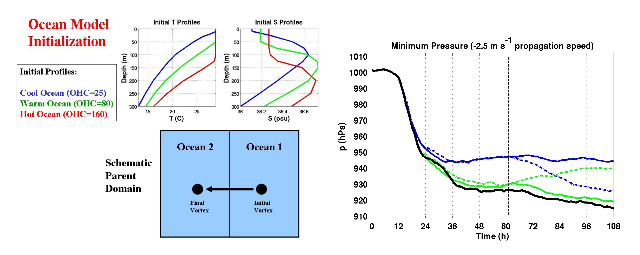Sensitivity of Hurricane Intensity Forecasts by the HWRF Version 3.2 Coupled Forecast Model
PIs: George Halliwell (NOAA/AOML)
Collaborators: Sundararaman Gopalakrishnan (NOAA/AOML/HRD), Xuejin Zhang (AOML/CIMAS), and Frank Marks (NOAA/AOML/HRD)
Coupled hurricane forecast models have contributed to significant improvements in track forecasts during recent years, but not in intensity forecasts. When atmospheric processes such as shear, dry air entrainment, and interaction with synoptic features do not exert a dominant influence on intensity, TC intensification (weakening) can occur as a storm passes over regions with high (low) upper-ocean heat potential. By contrast, there are many storms where little reaction occurs to changing ocean heat content due to the dominance of atmospheric processes, which makes it difficult to identify and quantify the oceanic impact on intensity. Even for storms where the oceanic influence is apparently significant, it is not possible to isolate the contribution of the ocean relative to atmospheric processes. In particular, we presently have a poor quantitative understanding of the expected intensity change that will result from the change in SST cooling rate when a storm moves from an ocean region with large heat content to one with small heat content, or vice-versa. We also have a poor quantitative understanding of the expected time scales over which the intensity will adjust in these situations.
The purpose of the present study is to perform analyses with a coupled TC forecast model in an idealized setup that minimizes the impact of atmospheric processes on intensity and thus isolates the impact of the ocean on TC intensity. The specific foci are (1) the initial intensification and the equilibrium intensity achieved over an ocean with horizontally-uniform heat content, and (2) the magnitude and time scale of intensity adjustment as a storm moves from a warmer to colder ocean region and vice-versa. The present analysis uses the new triple nested version of HWRF version 3.2 and couples it to a local one-dimensional ocean model. The ocean code was extracted from the HYbrid Coordinate Ocean Model (HYCOM) and uses the KPP vertical mixing parameterization. The ocean fields are initialized with either a horizontally-uniform ocean or with a “dual” ocean that allows a storm to equilibrate over one uniform ocean region an then cross into a different uniform ocean region (see Figure). The impact of this idealized ocean on hurricane intensity forecasts is also shown in Figure 1.

Figure 1. The left panels display a schematic diagram of the idealized model domain where either the same or different ocean conditions can be initialized on either side of the central longitude. Temperature and salinity profiles represent the three ocean conditions considered (cool, warm, and hot) are shown at the upper left. The right panel shows intensity evolution for several storms initialized from the same idealized vortex. The thick black line represents the case where SST is held constant at 28.85°C. The solid green and blue lines represent storms that passed over warm and cool ocean conditions, respectively, throughout the entire time interval. The dashed lines represent storms that passed from cool to warm ocean conditions and vice-versa.